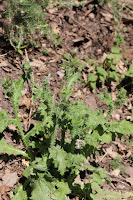Nederlands: Tengere distel
Español: Cardo
Français: Chardon à petits capitules
Deutsch: Dünnköpfige Distel
Family: Asteraceae - Daisy family
Flowering time: May-August
Height: 15-130cm
Altitude:
Colour: pale pink to bright purple
Flower: small (6-10mm) in compact clusters of 3 or more (up to 20) flowerheads
Leaves: lanceolate, lobed, spiny-margined, white-cottony beneath
Habitat: dry open habitats, roadsides, waste ground, grassy open places, close to the sea
Distribution: native to southern and western Europe and has spread from there to Central Europe













![English Botany, or Coloured Figures of British Plants, ed. 3 [B] [J.E. Sowerby et al], vol. 5: t. 682 (1866)](https://blogger.googleusercontent.com/img/b/R29vZ2xl/AVvXsEgTxrEYRjfR8kpPG2-xK9-utWxzoCYAMPeJpT21OoX54MVA-ZYBAi7_lCt-k_WmIPED5Jim7Flj8Y65NGdEJuts21nKsCCBD3lDB6n9sOLP_RLZukT9r_hfR-FdUygGftVAvF8dFxLjnIU/s200/Carduus+tenuiflorus+153624.jpg)
Notes: In the Netherlands Carduus tenuiflorusis has become very rare. One of the few places where it can be found is near the Afsluitdijk in the province of Noord-Holland. It is on the Dutch Red List of vascular plants. On other continents where Carduus tenuiflorus was introduced it is often considered a noxious weed. In the Sierra Nevada in southern Spain where these photographs are taken, three other species can be found: Carduus carlinoides subsp. hispanicus, Carduus platypus subsp. granatensis and Carduus pycnocephalus.
Related key words: Vereda de la Estrella, Sierra Nevada, Granada, Anducía, Andalusia, Andalusië, Spain, butterfly, Euphydryas desfontainii, Spanish Fritillary, insect, Nederlandse Rode Lijst, Wieringen

